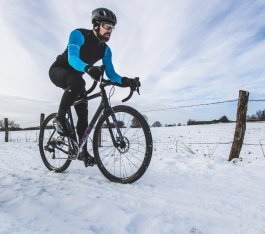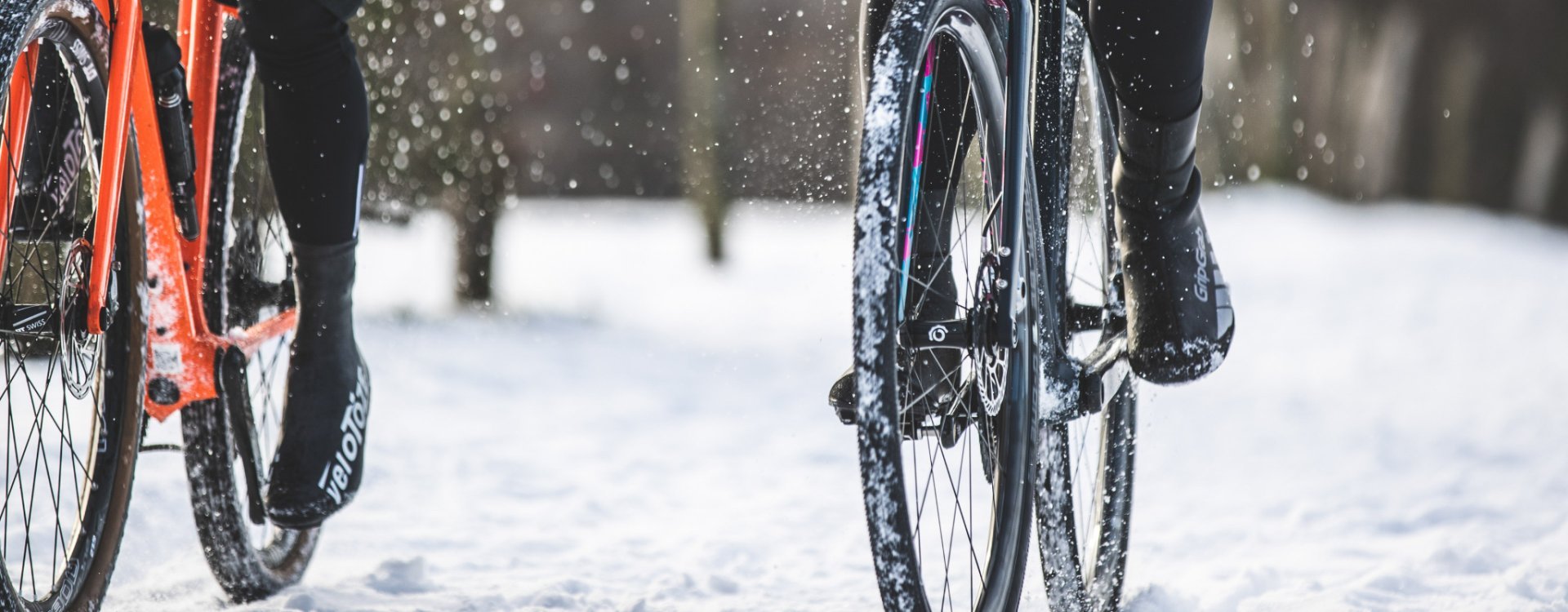
The ultimate guide to winter commuting
Cycling through autumn and winter: motivation, gear and safety tips. We’ll show you how to get yourself and your bike ready for the cold season.
Winter riding means cold feet? Not anymore! With our tips, you can banish freezing toes and enjoy every chilly ride.
The thermometer shows under five degrees, drizzle hangs in the air, and an icy wind whips around your ears – but skipping your bicycle ride because of that? No way!
To keep your feet from freezing after just a few kilometres, we’ll show you how to keep them warm when cycling in winter. We explain why your feet cool down so quickly on the bike, how the right cycling shoes, shoecovers and socks help, and what else you can do to avoid common cold traps.
With the right gear, winter rides can stay warm and comfortable. © bc GmbH

Cold feet can ruin a ride — here’s how to prevent them. © bc GmbH
When you head outside in winter temperatures, your body has to work to keep your core at its ideal 36–37 °C. To do this, it activates a proven protection mechanism: blood vessels in the skin and extremities constrict, reducing blood flow (and therefore warmth) to your feet. This minimizes overall heat loss and helps maintain core temperature. The downside: if your feet aren’t well protected, they cool down quickly. If you'd also like to know how to prevent cold fingers while cycling, you can find a detailed guide in our article: Cold Hands While Cycling? Not With Us!.
While cycling, your feet get cold even faster because a major cold booster comes into play: wind! Your feet are fully exposed to the airstream and move continuously – but unfortunately passively. The warm air layer around your skin is simply blown away, lowering the perceived temperature. This is called the windchill effect. The faster you pedal and ride, the stronger the wind and the quicker your feet freeze in low temperatures.
Another factor contributing to heat loss is moisture. Whether from rain, puddles or sweaty socks – wet feet are a guaranteed recipe for icy toes.
By the way: an incorrect riding position or an ill-fitting saddle can also restrict blood flow and reduce warmth in your feet. If your saddle is too high or its shape doesn’t suit you, less blood may reach your feet, making them cold more quickly. A pinched nerve may also cause numbness, so you don’t notice the cold until it hurts.
A poorly adjusted saddle can also lead to cold or numb feet.
You’ll find winter cycling shoes with cleats for Rennrad, gravel bikes and MTB, as well as full-sole models for platform pedals. To counter cold triggers like moisture and wind, breathable, waterproof and windproof materials are essential. In short: winter bike shoes must reliably block cold air and creeping moisture. MTB and gravel shoes also need to handle mud well, and for clipless shoes, the area around the cleats should be well insulated to prevent cold bridges.
The winter shoes in our shop feature a breathable, windproof and waterproof membrane. Combined with thermal insulation, a thermal insole and a high ankle cuff, your feet stay warm and dry even in wet and cold conditions. Choose your winter shoes slightly larger to leave room for thick socks. Ideally, try them on with your winter socks. If the shoes are too tight, blood circulation is restricted and there isn’t enough room for an insulating air layer between your foot and the shoe. Result: cold feet despite winter shoes.
Winter cycling shoes are one of the most obvious and effective ways to keep feet warm. © bc GmbH
For cycling, there are overshoes that you can pull over your clipless cycling shoes to protect your feet from wind and water. They can’t match the insulation performance of dedicated winter cycling shoes, but they’re a great option if you only ride short distances or occasionally in the cold and want to keep using your summer shoes. For everyday shoes, gaiters can help. There are now overshoes designed for flat-soled shoes (i.e. not for clipless pedals), which are perfect if you commute in regular footwear and want to avoid wet feet.
Winter overshoes should block wind and water and be thick enough to insulate your feet from the cold. For best insulation in truly wintry conditions, we recommend thick, waterproof neoprene overshoes or fleece-lined PU or rubber models. Which type is “better” is mostly personal preference. For very cold days (or if you get cold easily), combining winter shoes with overshoes works great.
For mild days when you mainly need wind protection, toe covers (toe caps) are a good choice. They shield your toes from the cold. If you only need rain protection, go for lightweight waterproof rain overshoes. In heavy rain, combine them with waterproof gaiters or rain cuffs to stop water from running into your overshoes or shoes.
If you use overshoes, avoid walking in them too much. Since they extend under the sole, they touch the ground with every step and wear out more quickly. For rides with a lot of hike-a-bike sections, winter cycling shoes are the better choice—they’re more robust and protect better against moisture from below.
Toe caps protect the forefoot and are easy to pack. © bc GmbH
Full overshoes take a bit more effort to put on, but offer helpful extras like waterproofing or high visibility. © bc GmbH
If your feet are freezing despite wearing warm socks on the bike, it's worth checking how much moisture is building up inside your shoes. Your shoes need to handle moisture — but so do your socks! In cold weather, breathable thermal socks or thick merino socks work best. Merino excels at moisture management, and its fibres are naturally odour-resistant. Regular cotton socks or Grandma’s knitted wool socks are not suitable for winter riding: they soak up moisture, and wet socks inevitably lead to … cold feet!
Waterproof socks can be an alternative to overshoes if you have enough room inside your shoes. They come in different designs: some consist of an inner and outer sock with a waterproof membrane in between, while others are simply a membrane you pull over your cycling socks. Their advantage over overshoes: they won’t get damaged when walking and are easier to put on. However, their insulation is limited because they are the last (or second-to-last) layer next to your foot. In cold, wet conditions, the outer layers will already be wet and cold, meaning your foot will also get colder than with winter shoes or overshoes.
Winter cycling socks range from warm to fully waterproof. © bc GmbH

Targeted foot exercises can help keep your feet warm and your circulation going in cold weather. © bc GmbH
Foot exercises are great for keeping your feet warm! Move your toes and ankles actively while pedalling. During short breaks off the bike, circle your feet, shake out your legs, or bounce a little. You can also add a short walking section (as long as it doesn’t ruin your overshoes) — it boosts circulation. Avoid standing still during breaks, as your whole body cools down quickly.
Make sure your shoes aren’t too tight. They need to be the right size and shouldn’t be laced too firmly. If cycling shoes are too tight, you can’t move your feet well and less blood — and therefore less warmth — reaches your toes. A good rule of thumb: curl your toes, then tighten your shoes.

The best choice is breathable thermal socks or thick merino socks. Wearing several thin layers can restrict your feet and make them cold more quickly.
It depends on usage and materials. If you ride several times per week in mud or road salt, gently clean your shoes after each ride and re-waterproof them every three to four weeks.
Waterproof membrane socks can help keep your feet warm. However, waterproof winter shoes or cycling overshoes are more effective, as they keep moisture away from your feet across several layers.
Newspaper absorbs moisture and is great for drying wet shoes. Always start your ride with dry shoes and socks to keep your feet warm.
If your feet go numb while cycling, try moving the cleats slightly further back. Often, the issue is an ill-fitting shoe, insufficient width, or laces/closures that are too tight.
Thermal insoles often use an aluminum layer to reflect heat combined with insulating layers. Household aluminum foil is not suitable: it tears easily, forms hard lumps and conducts heat extremely well.
You can improve summer shoes with thermal socks, winter insoles and thick overshoes. But if you ride often in the cold or your feet freeze quickly, investing in proper winter cycling shoes is worth it.